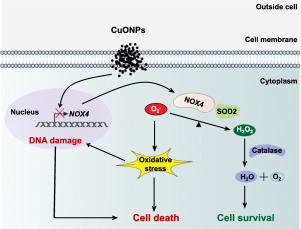Our official English website, www.x-mol.net, welcomes your feedback! (Note: you will need to create a separate account there.)
The NADPH oxidase 4 protects vascular endothelial cells from copper oxide nanoparticles-induced oxidative stress and cell death.
Life Sciences ( IF 6.1 ) Pub Date : 2020-03-19 , DOI: 10.1016/j.lfs.2020.117571 Hui He 1 , Shiquan Xiao 2 , Ge Xu 3 , Bin Wang 3 , Zhen Zou 3 , Xia Qin 1 , Chao Yu 1 , Jun Zhang 3
Life Sciences ( IF 6.1 ) Pub Date : 2020-03-19 , DOI: 10.1016/j.lfs.2020.117571 Hui He 1 , Shiquan Xiao 2 , Ge Xu 3 , Bin Wang 3 , Zhen Zou 3 , Xia Qin 1 , Chao Yu 1 , Jun Zhang 3
Affiliation

|
AIMS
Nanoparticles (NPs) exposure is associated with increased risk of cardiovascular diseases, but the underlying mechanism is still obscure. In this study, we investigated the role of NADPH oxidase 4 (NOX4) in copper oxide nanoparticles (CuONPs)-induced cytotoxicity in human umbilical vein endothelial cells (HUVECs).
MATERIALS AND METHODS
Morphology changes were examined under the microscope. Cell viability was determined by MTS assay and Calcein AM assay. Apoptosis and the levels of superoxide anion (O2-) and hydrogen peroxide (H2O2) were measured by fluorescence activated cell sorting (FACS). Oxidative stress was detected by assaying the levels of glutathione/glutathione disulfide (GSH/GSSG) and malondialdehyde (MDA). Protein expression levels were determined by western blotting.
KEY FINDINGS
We revealed that O2- rather than H2O2 was the major component of reactive oxygen species (ROS) in CuONPs-treated HUVECs. Meanwhile, CuONPs downregulated expression of O2--eliminating enzyme NOX4 both at mRNA and protein levels, but did not affect the expression of SOD2 and catalase. NOX4 knockdown caused more accumulation of O2-, and a further decrease of H2O2 in CuONPs-treated HUVECs, suggesting that NOX4 regulates the conversion of O2- to H2O2 in CuONPs-treated HUVECs. Furthermore, we revealed that NOX4 knockdown aggravated CuONPs-induced oxidative stress, characterized by a decrease of GSH/GSSG ratio, an increase of MDA level, and upregulation of HSPA5 and γH2AX. Finally, we showed that NOX4 knockdown exacerbated CuONPs-induced apoptotic cell death in HUVECs, indicating that NOX4 could protect ECs from CuONPs-induced cell death.
SIGNIFICANCE
Our study provides the evidence that NOX4 protects vascular endothelial cells from CuONPs-induced oxidative stress and cell death.
中文翻译:

NADPH氧化酶4保护血管内皮细胞免受氧化铜纳米颗粒诱导的氧化应激和细胞死亡的影响。
AIMS纳米颗粒(NPs)暴露与心血管疾病的风险增加相关,但其潜在机制仍不清楚。在这项研究中,我们调查了NADPH氧化酶4(NOX4)在氧化铜纳米颗粒(CuONPs)诱导的人脐静脉内皮细胞(HUVECs)细胞毒性中的作用。材料与方法在显微镜下观察形态变化。细胞活力通过MTS测定和钙黄绿素AM测定来确定。通过荧光激活细胞分选术(FACS)测量细胞凋亡以及超氧阴离子(O2-)和过氧化氢(H2O2)的水平。通过测定谷胱甘肽/谷胱甘肽二硫化物(GSH / GSSG)和丙二醛(MDA)的水平来检测氧化应激。通过蛋白质印迹确定蛋白质表达水平。主要发现我们发现,在CuONP处理过的HUVEC中,O2而不是H2O2是活性氧(ROS)的主要成分。同时,CuONPs在mRNA和蛋白水平上都下调了O2消除酶NOX4的表达,但不影响SOD2和过氧化氢酶的表达。NOX4敲低会导致Cu2 +处理过的HUVEC中更多的O2-积累,并进一步减少H2O2,这表明NOX4调节CuONPs处理的HUVEC中O2-向H2O2的转化。此外,我们发现,NOX4敲低会加剧CuONPs诱导的氧化应激,其特征在于GSH / GSSG比降低,MDA水平升高以及HSPA5和γH2AX上调。最后,我们表明,NOX4敲低加剧了HUVEC中CuONPs诱导的凋亡细胞死亡,这表明NOX4可以保护EC免受CuONPs诱导的细胞死亡。
更新日期:2020-03-20
中文翻译:

NADPH氧化酶4保护血管内皮细胞免受氧化铜纳米颗粒诱导的氧化应激和细胞死亡的影响。
AIMS纳米颗粒(NPs)暴露与心血管疾病的风险增加相关,但其潜在机制仍不清楚。在这项研究中,我们调查了NADPH氧化酶4(NOX4)在氧化铜纳米颗粒(CuONPs)诱导的人脐静脉内皮细胞(HUVECs)细胞毒性中的作用。材料与方法在显微镜下观察形态变化。细胞活力通过MTS测定和钙黄绿素AM测定来确定。通过荧光激活细胞分选术(FACS)测量细胞凋亡以及超氧阴离子(O2-)和过氧化氢(H2O2)的水平。通过测定谷胱甘肽/谷胱甘肽二硫化物(GSH / GSSG)和丙二醛(MDA)的水平来检测氧化应激。通过蛋白质印迹确定蛋白质表达水平。主要发现我们发现,在CuONP处理过的HUVEC中,O2而不是H2O2是活性氧(ROS)的主要成分。同时,CuONPs在mRNA和蛋白水平上都下调了O2消除酶NOX4的表达,但不影响SOD2和过氧化氢酶的表达。NOX4敲低会导致Cu2 +处理过的HUVEC中更多的O2-积累,并进一步减少H2O2,这表明NOX4调节CuONPs处理的HUVEC中O2-向H2O2的转化。此外,我们发现,NOX4敲低会加剧CuONPs诱导的氧化应激,其特征在于GSH / GSSG比降低,MDA水平升高以及HSPA5和γH2AX上调。最后,我们表明,NOX4敲低加剧了HUVEC中CuONPs诱导的凋亡细胞死亡,这表明NOX4可以保护EC免受CuONPs诱导的细胞死亡。



























 京公网安备 11010802027423号
京公网安备 11010802027423号